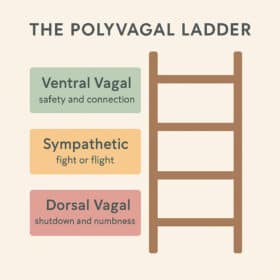Vagus Nerve Healing
The Superhighway to Recovery
If you’re living with chronic illness, anxiety, fatigue, digestive issues or trauma, your vagus nerve might be playing a bigger role than you think.
This page explores the power of vagus nerve healing, and why it’s such a vital part of restoring balance, safety, and connection within your body. It’s one of the most important nerves in your body, yet it’s often completely overlooked.
Understanding how your vagus nerve works isn’t just interesting, it can be life-changing. This powerful nerve plays a central role in your nervous system, your immune system, and your overall sense of wellbeing.
It’s the key to moving out of survival mode and into a place where your body can start to heal. This is what we mean by vagus nerve healing, bringing balance back to a system that’s been trying to cope on its own for too long.
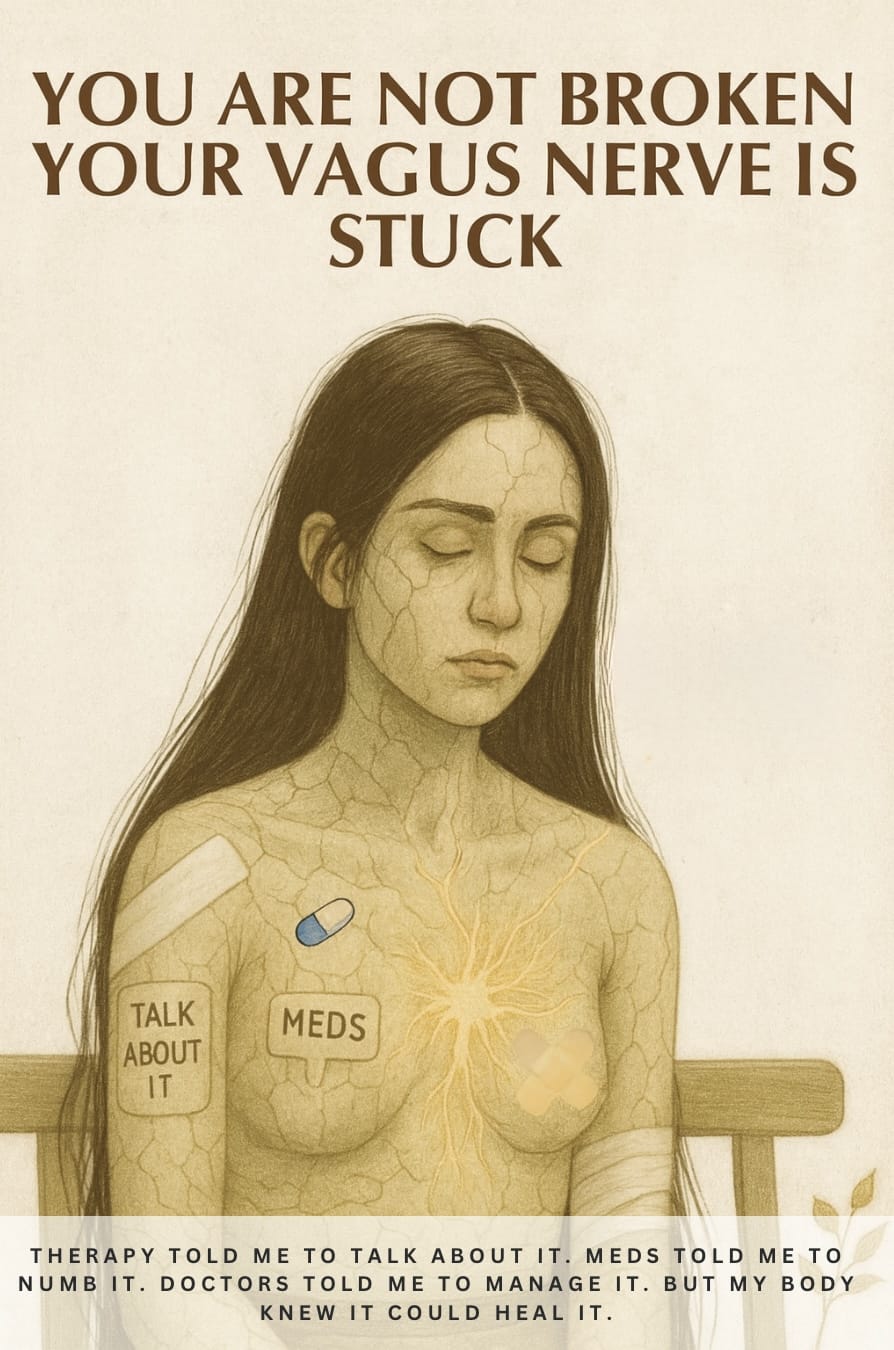
What is the vagus nerve?
The vagus nerve (from the Latin for “wandering”) is the longest cranial nerve in the body. It starts in the brainstem and travels down through the neck and chest, branching into your heart, lungs, and digestive system. It’s involved in nearly every automatic function your body performs, like breathing, heart rate, digestion, and even speech.
It’s a core part of your parasympathetic nervous system, your “rest and digest” state. And what makes it so important is that it works in both directions. It carries signals from your brain to your body, but also from your body to your brain. So how you breathe, move, eat, and connect with others all influence how your vagus nerve functions.
You can think of it as a kind of superhighway, a two-way road that carries constant messages between your body and your brain. If your body feels calm and safe, your brain gets that message. If your body feels stressed or overwhelmed, your brain gets that, too. And this feedback loop is what often determines how you feel moment to moment, physically, emotionally, energetically. Supporting this feedback loop is the heart of vagus nerve healing.
Why Vagus Nerve Healing Matters
Because without a healthy vagus nerve, the body struggles to regulate itself. And regulation is everything. It affects how you feel when you wake up, how you digest food, how easily you connect with others, how quickly you recover from stress, and how deeply you sleep. It influences your mood, your energy, and even your ability to trust yourself. Nervous system regulation depends heavily on vagus nerve regulation.
A well-toned vagus nerve helps you:
- Calm down after stress
- Digest food properly
- Sleep more deeply
- Feel safer in your body and around others
- Reduce inflammation
- Recover from illness faster
- Regulate emotions more easily
- Maintain steady energy throughout the day
When vagus function is low (sometimes called low vagal tone), you’re more likely to feel stuck in fight-or-flight or freeze. That might show up as panic, chronic stress, IBS, dissociation, hormonal imbalances, poor immune function, or fatigue. You might feel emotionally flat, or flooded. And you might find that you’re always either wired or exhausted, rarely in between.
It can also change the way you experience the world. When your nervous system is dysregulated, everything can feel harder, louder, faster, more urgent. You might feel disconnected from your body, or hyper-aware of every internal sensation.
Small things might feel overwhelming. Big things might feel impossible. Even joy and excitement can feel too much.
Sometimes, people describe it as living in a body that doesn’t feel safe, or doesn’t feel like theirs. And that’s incredibly difficult to navigate. But it’s also something that can change through intentional vagus nerve healing.
Polyvagal Theory – The Three Stages of Response
Polyvagal Theory, developed by Dr Stephen Porges, helps explain how the vagus nerve influences our physical and emotional states. It describes three main stages of response:
- Dorsal Vagal State (Shutdown) – When your system perceives overwhelming danger, it can trigger a freeze or shutdown response. This can feel like numbness, disconnection, or extreme fatigue.
- Sympathetic State (Mobilisation) – This is the fight-or-flight response. Your body prepares for action, increasing heart rate and alertness. It’s useful for short-term stress but exhausting if it becomes chronic.
- Ventral Vagal State (Safety and Connection) – When this branch of the vagus nerve is active, you feel calm, connected, and engaged. Your body is in a regulated state, allowing for social connection, creativity, and healing.
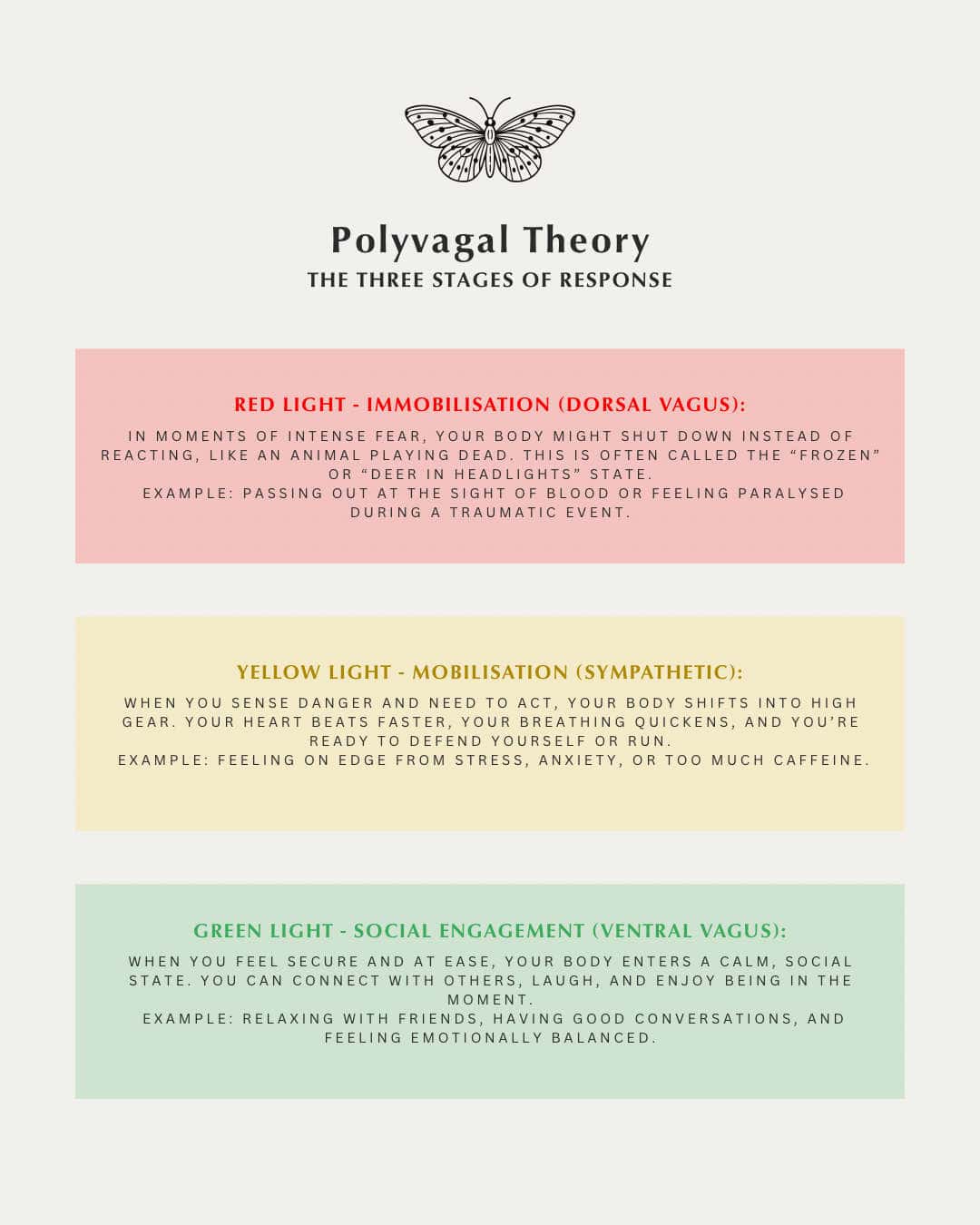
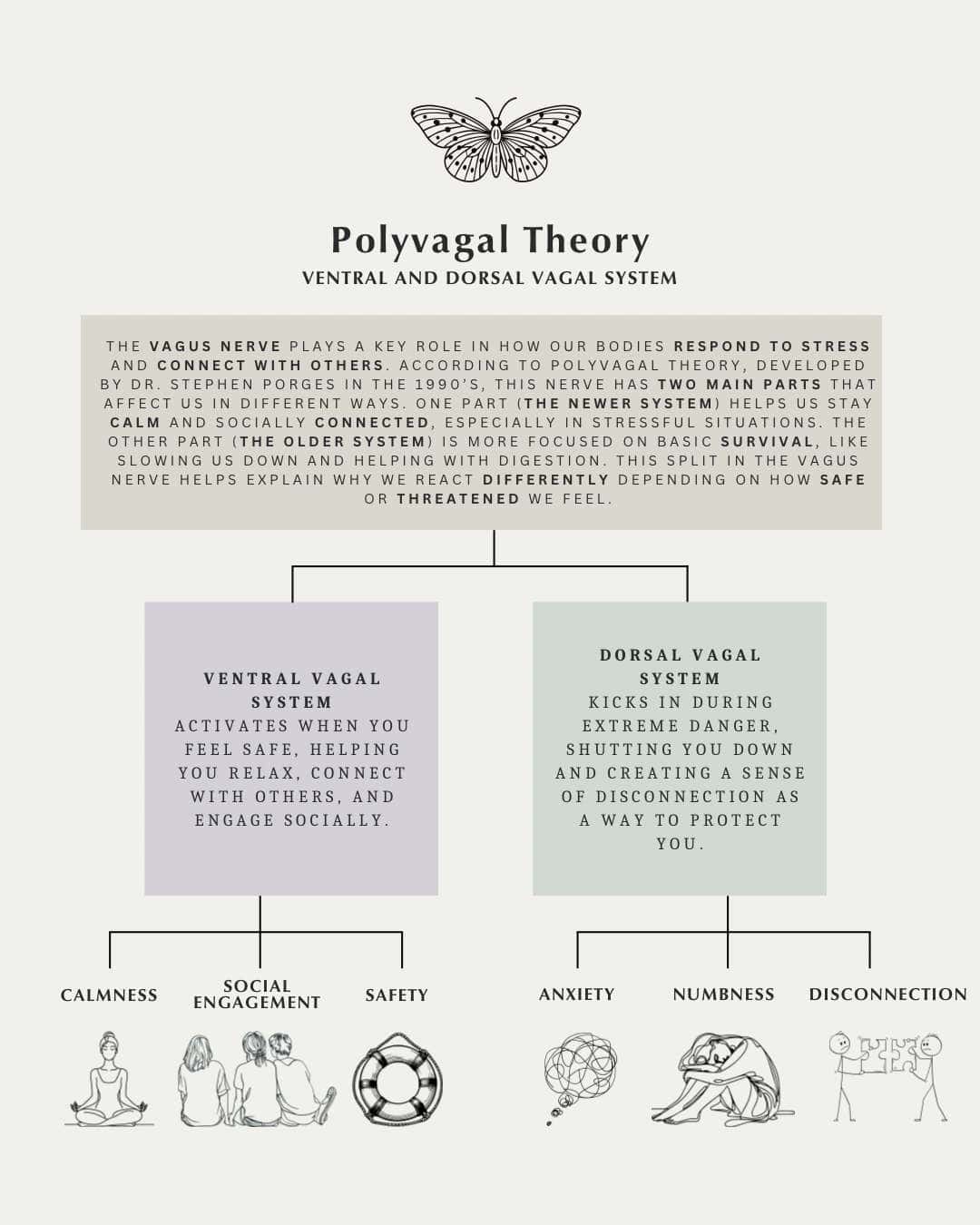
Understanding these states helps in vagus nerve healing because it shows that regulation isn’t about avoiding stress entirely, but learning how to move back into the Ventral Vagal state more easily.
The Polyvagal Ladder
One helpful way to visualise these three states is through what’s known as the Polyvagal Ladder.
This ladder is a simple framework that shows how we move up and down between these states in response to safety or danger. At the top is the Ventral Vagal state, in the middle is the Sympathetic state, and at the bottom is the Dorsal Vagal state.
You can read more about how this works, and see a clear diagram of the ladder, on our dedicated Polyvagal Ladder page
How to Support Vagus Nerve Healing
You don’t need fancy equipment or complicated tools. Your vagus nerve responds to natural, gentle inputs that promote connection and presence. Some simple ways to begin supporting it include:
- Breathing slowly and deeply
- Singing or humming
- Splashing your face with cold water
- Gently massaging your neck or ear
- Prioritising rest and sleep
- Spending time with people who feel safe
- Moving your body in mindful, non-stressful ways
You can also support your vagus nerve through what you eat, how you sleep, and the way you speak to yourself. Gut health plays a role. So does emotional safety. Even the music you listen to can affect it. Nature, laughter, creativity, meaningful connection, all of these matter. These are small acts, but repeated consistently, they send powerful messages of safety to your nervous system. This is what makes natural vagus nerve healing so accessible.
This is also where hypnotherapy and nervous system regulation come in. By guiding the body and mind into a calm, receptive state, we create the conditions that allow the vagus nerve to reset, strengthen, and begin functioning optimally again. Hypnosis is one of the most direct ways to shift into a parasympathetic state, making it a powerful tool for vagus nerve healing.
This isn’t about fixing you. You’re not broken. But your system might be stuck in a protective loop that no longer serves you. When we work together, we explore how your body is trying to keep you safe, and how to build new internal pathways that lead you somewhere different. Somewhere safer. Somewhere softer.
It’s not about doing more. It’s about doing less, but doing it with care, consistency, and compassion. Real healing often begins in the quiet moments, the ones where you feel just a little more settled, a little more hopeful, a little more at home in yourself.
If you’re curious about how this approach to vagus nerve healing could help you, you’re welcome to get in touch.
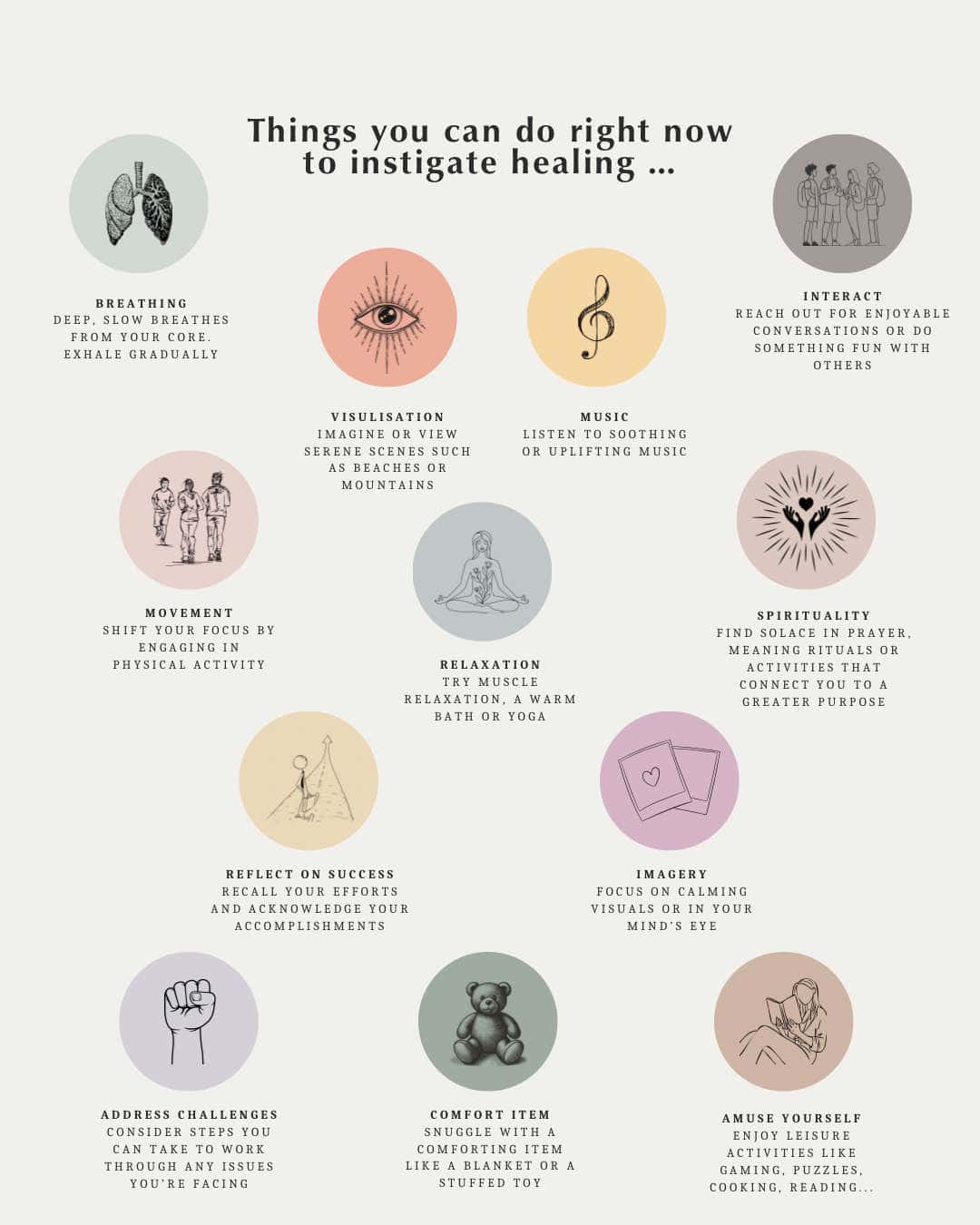
FAQs
Gentle breathwork, soft humming, warm connection with safe people, and relaxing practices like self-hypnosis or mindful movement can all help calm the vagus nerve. The key is consistency and sending signals of safety to your system. Calm doesn’t come from force, it comes from repetition and care.
Resetting the vagus nerve involves creating the right conditions for it to shift out of survival mode. That might include calming inputs (like deep breathing or meditation), reducing daily stressors, improving sleep quality, and working with tools like hypnotherapy or somatic awareness. It’s a process, not a switch.
Yes. The vagus nerve responds well to consistent, gentle practices that signal safety. Breathing, sleep, connection, movement, and therapies like hypnotherapy can all help restore vagal tone. There’s no single magic practice, it’s the accumulation of small, safe experiences over time. Natural vagus nerve healing is entirely possible when approached with care.
It varies. Some people feel improvements within days or weeks. For others, especially if the nervous system has been dysregulated for years, it takes longer. What matters most is consistency and compassion. There’s no rush, just a steady commitment to creating safety in your system through vagus nerve regulation.
Trauma can cause the vagus nerve to go into shutdown or hyperarousal, making it harder to regulate emotions and physical responses. In trauma states, the vagus nerve often acts like a faulty alarm system, either stuck on high alert or shutting things down completely. Healing the vagus nerve is a key part of trauma recovery because it restores that middle ground where calm, connection, and curiosity can return.
Yes, but it needs to be done gently. If your system is highly sensitive, even calming practices can sometimes feel too much. That’s why it’s important to go slowly and work with someone who understands how to support nervous system regulation. There’s no one-size-fits-all approach, this work is deeply individual and deeply human.
Common signs include digestive problems, chronic inflammation, anxiety, low mood, poor sleep, fainting spells, cold hands and feet, and feeling easily overwhelmed or emotionally flat. Some people also experience chronic pain, fatigue, or a sense of disconnection from their body.
It varies. Some people feel improvements within days or weeks. For others, especially if the nervous system has been dysregulated for years, it takes longer. What matters most is consistency and compassion. There’s no rush, just a steady commitment to creating safety in your system through vagus nerve regulation.
Yes, but it needs to be done gently. If your system is highly sensitive, even calming practices can sometimes feel too much. That’s why it’s important to go slowly and work with someone who understands how to support nervous system regulation. There’s no one-size-fits-all approach, this work is deeply individual and deeply human.

